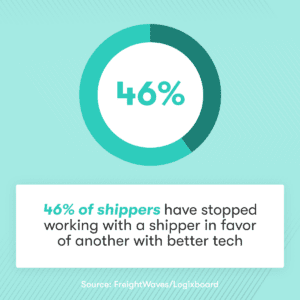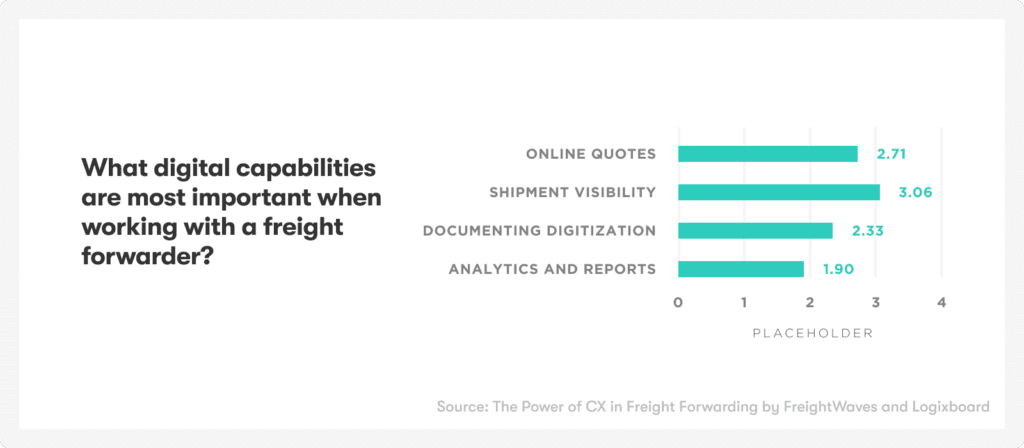In this article
Competition among freight forwarders is intensifying across the market, as shippers seek more reliable and cost-effective logistics solutions. As many shippers scan the market to find better partners, it’s important to know what they’re looking for in order to satisfy your customers and pick up prospects who are open to a change.
Let’s talk about the top reasons shippers switch forwarders, and how you can use those trends to acquire and retain customers.
Jump to a section ?
1. Price
Any experienced shipper knows that price is hardly the most important factor in choosing a logistics partner. After all, opting for a cheaper provider is never worth the delays and fees that might arise as a result.
However, in a competitive market like freight forwarding, you can’t get away from the importance of price. As one Xeneta customer said, “At the end of a bidding process, the decision is often based solely on price. Why? It’s the easiest way to measure a partner.” Therefore, as shippers re-evaluate their forwarders this season, many will be comparing price tags to find the most cost-effective option.
How you can win
In a tight market like freight forwarding, you can’t always guarantee the lowest price. Especially in a fluctuating market, competing to offer the lowest price can be like a race to the bottom. In times of excess capacity, container rates can go to zero, or even into the negatives.
Instead of differentiating on price alone, you can focus on providing the best value to your shippers. In other words, figure out how to present the big picture. You can try to accomplish this by highlighting the intangible savings from working with you, such as high on-time in full (OTIF) rates, lower fees, or low damage rates. This could mean offering additional services or options that the competitor doesn’t offer, such as faster transit times or more flexible scheduling.
In sales conversations, explain your process and how you manage to lower costs for your customers. If possible, you’ll want to pull out data from your previous jobs to show prospects the difference.
2. Service
Service is another crucial factor that can influence a shipper’s decision to switch forwarders. After all, superior customer service is a top reason why shippers opt to pay for a freight forwarder rather than working directly with carriers.
When a shipper signs up with a freight forwarder, they’re putting trust in their promise that they’ll transport their goods quickly and safely. If that trust breaks apart, the customer might have a lot to lose. For that reason, if shippers experience poor service, they may be quick to consider other options.
Some service issues that might drive shippers away include:
- Hidden or unexpected fees
- Inaccurate or misleading information about services or pricing
- Lack of compliance with regulations or industry standards
- Security breaches or thefts of goods
- Poor ethical or environmental practices
How you can win
While bad customer service is enough to drive a freight forwarder away, exceptionally good customer service isn’t necessarily enough to win them over. After all, in an industry like freight forwarding, almost everybody offers amazing customer service.
Even if you have the best, most experienced team in the industry, you still need to get the opportunity to impress potential customers. To lure them in, you need to give them a reason to trust you.
In your initial sales proposal, pull in examples and data from your previous customers. For instance, you can gather customer testimonials or cite metrics like transit time, damage/loss rates, or NPS scores.
You can also keep presenting your performance to customers after signing to drive retention and expansion. If you have a customer experience platform, you may be able to use it to give them access to their data. Otherwise, you can also hold regular QBRs to review your strengths and areas for improvement.
3. Technology
Technology is becoming increasingly important in the logistics industry. In fact, in a recent FreightWaves/Logixboard survey, 46% of shippers have stopped working with a freight forwarder because another offered better tech. Shippers want to work with partners who have the latest tools and systems to streamline the shipping process and provide better visibility and control over their shipments.
However, technology can be a double-edged sword. Shippers don’t necessarily want to work with a forwarder who outsources all of their requests to a bot or virtual helper. In other words, it’s about digital compatibility– not blindly implementing the latest innovation.

How you can win
If you’re starting from zero, you’ll want to begin your tech upgrade by finding out what features your shippers value. According to our survey, shippers ranked shipment visibility highest, followed by online quotes. However, your customers’ priorities might not line up with the majority of shippers. Therefore, it’s best to seek their feedback for better insights.

From there, you can figure out how to implement that technology, starting with whether to buy your software or build it in-house. For well-funded logistics giants with a heavy investment in tech, building custom software can yield returns at high volumes. However, as a rule of thumb, buying a solution is typically the best choice for getting started due to the low initial cost, built-in maintenance, and quick time to value.
Once you’ve settled on a solution, it’s time to determine how to maximize value from your system. Even for businesses who’ve already undergone a digital transformation, change management is often a key area of improvement to achieving ROI.
For many organizations, this consists of a variety of tasks, including:
- Integrating new solutions into your existing system
- Working with consultants to make the most out of each tool
- Investing in training for employees
- Giving your team a transition period to adopt new solutions
- Gathering feedback from staff and customers on the effects of new software
“I’m going to ask you to spend a little bit more money in doing this audit of your system, having a look at your processes, re-engineering those, and running the SOPs. And let’s look at how we can increase your number of jobs with your current headcount, or let’s look at how we can reduce the amount of overtime your staff are working.”
– Maryann Farrugia, managing director of Offshore Business Processing
Final thoughts
By understanding the top reasons why shippers may switch forwarders, you can take steps to address these issues and retain your customers. Whether it’s driving home value, leveling up your services, or implementing new technology, there are many ways to stay ahead of the competition and win new business. By focusing on these areas, you can build strong relationships with your customers and achieve long-term success as a freight forwarder.
Ready to invest in customer acquisition and retention this year? With a customer experience platform like Logixboard, you can give your prospects what they’re looking for. Connect with our team to learn more.
READ MORE FROM THE LOGIXBOARD BLOG

